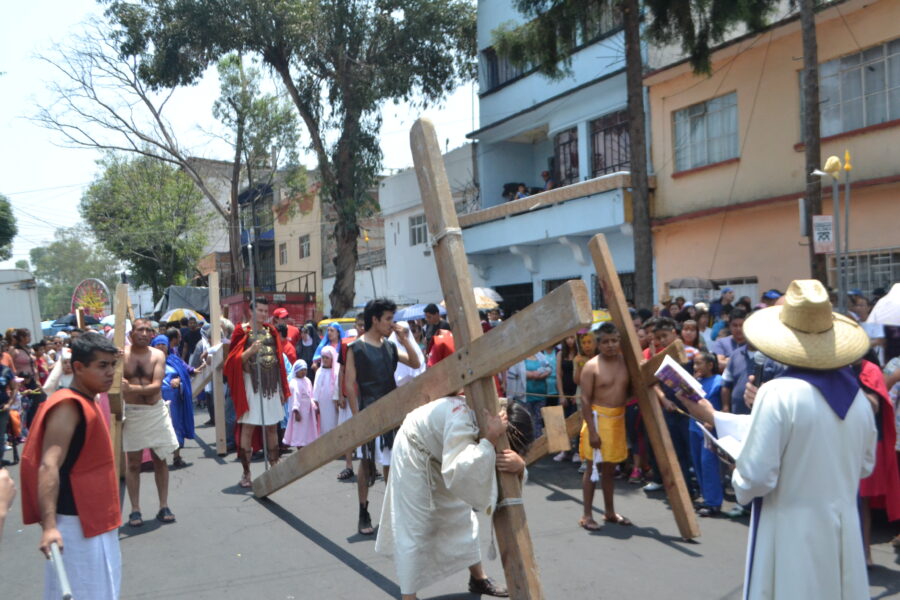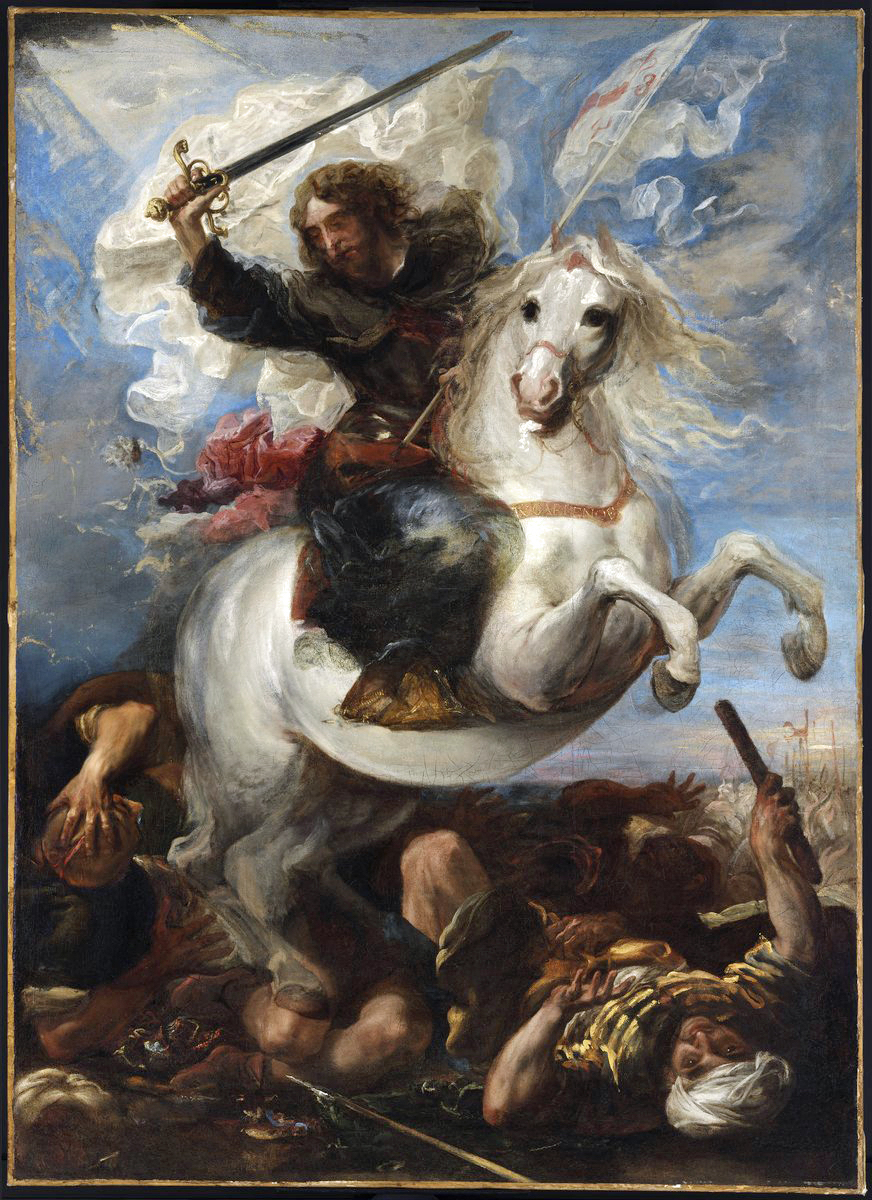|
Getting your Trinity Audio player ready...
|
Above: a painting of Santiago Matamoros (St. James the Moor Slayer) by Juan Carreño de Miranda (1614-1685)
Of Our Lord’s inner circle, to Peter He gave His Church, to John He gave His Mother, and to James He gave Spain.
~ Spanish saying
The Pilgrimage of Nuestra Señora de la Cristiandad to Covadonga in Spain concluded last year on the eve of the Solemnity of St James the Greater, Apostle and Patron of Spain, celebrated the following day on Tuesday 25th July. My fellow pilgrims and I marked this day by venerating the Sudarium (sweat-cloth) in the Cámara Santa (Holy Chamber) of Oviedo Cathedral. This Sudarium is purported to be the sweat-cloth placed on Our Lord’s head in the Sepulcher. Compelling evidence gives a strong basis for this historical veneration.
Given the Pilgrimage’s major intention – for the restoration of a Christian social order – the pilgrimage’s timing leading up to the feast of St James the Apostle was highly fitting, for what is most necessary for the reconstitution of a Christian social order is the restoration of the spirit of Christendom.
St James the Greater, brother of St John the beloved, son of Zebedee and Salome, and called a “Son of Thunder” by Our Lord, is a great model of the spirit of Catholic militancy that we Catholics must cultivate. Though rebuked by Our Lord for wanting to command fire from heaven to come down on a city of the Samaritans that rejected Christ (Luke 9:52-56), since the “Son of Man did not come to destroy men’s souls but to save them,” St James became the proto-martyr of the Apostles and patron saint of soldiers and pilgrims, as well as of the nation of Spain. Perhaps the zealous temper of St James contributed to Herod Agrippa choosing him as the first victim: “He killed James, the brother of John, with the sword” (Acts 12:1-2).
It is believed that his inclusion in Our Lord’s inner circle was partly due to him being the first of the apostles to follow his Master on the Royal Road of Martyrdom; the supreme imitation of Christ ever since, and a road we must willingly accept if we are to be truly militant.
Blessed Anne Catherine Emmerich described a vision she had of St James’ apostolic ministry:
From Jerusalem, St. James went to Sicily and then to Spain, stopping in Cadiz for a while. He was not well received, and was saved from being murdered by an Angel. He left Spain to seven disciples.
Later, I saw St. James in danger because of the persecution against the faithful in Saragossa. I saw the Apostle praying at night with some disciples near the walls of the city. He was asking for enlightenment to know if he should stay in that region or go elsewhere. He directed his thoughts to Most Holy Mary and asked her to intercede with her Divine Son, Who could not deny her anything.
Suddenly, I saw a heavenly splendor come over the Apostle. Angels, singing harmoniously, carried down a column of light whose base they set on the place in which a church should be built. The column was tall and elegantly narrow, ending in the shape of an open lily which sent sparks of light in many directions. One of them went to Compostela. In the splendor of the lily I saw the Most Holy Mary, transparent and white like snow, with a delicacy and beauty greater than silk. She was standing as she used to pray. Her hands were joined, and a long veil on her head fell to her feet, which lightly touched the lily that shone with five rays of light. This vision of Our Lady was the origin of the devotion to Our Lady of the Pillar.
While the vision was taking place, St. James received a message interiorly that he should build a church on that site, and that the devotion to Our Lady would be established there, take root, and expand. The Holy Virgin told him that once the church was built, he should return to Jerusalem. Indeed, later, when the work was completed, the Apostle left it in charge of twelve disciples he had formed and left.
It seems something of St James’s combative personality both corresponded to and helped shape the national temperament of the Spanish people that he evangelised. Now the notion of a ‘national temperament’ is a deeply mysterious one, but one that is nevertheless testified to in countless personal anecdotes, cultural artefacts, and literature over the centuries. Influenced by climate, geography, and history, the temperament of a given nation (a kind of family of families) can even be said to be spiritually rooted in what Dr Plinio Corrêa de Oliveira called a “primordial light”; a kind of unique vocation given by God to each people to reflect some aspect of Himself.
Don Miguel Ayuso expressed something of the Spanish primordial light when he said that, “Spain is the incarnation of Christian chivalry.” By chivalry we mean the Christianisation of the sword. Spain was one of a small number of nations (along with Portugal and the Baltic nations) that were forged by a crusade; it is thus marked from the beginning by the peculiar character of war and conquest for Christ. Mysteriously, the Roman legionaries who crucified Our Lord are traditionally thought to have been from Iberia. The etymology of the very name España may even derive from Espiña – thorn. Here we may speculate on the origin of the particularly Spanish passionist and crucicentric spirituality which places great emphasis on the suffering of Our Lord and Our Lady on Calvary which we can still see in the solemn and penitential Semana Santa processions in Spain today – one of the most precious surviving relics of her Christian past.

After the fall of Christian Visigothic Spain in the eighth century, the terrible pressure of the Mohammedan invasion of Iberia was the force which providentially forged the disparate elements of the Gothic, the Hispano-Roman and the Catholic faith together into a distinct nation. St James – the great Santiago – did not forget the country that he laboured in, famously intervening from Heaven on behalf of the beleaguered Christian forces at the Battle of Clavijo, earning the title of Santiago Matamoros (St James the Moor-slayer).
Dom Prosper Guéranger writes:
But what are those sudden shouts coming down from the mountains, and echoing through the valleys? Who is this unknown chief rallying against an immense army the little worn-out troop whose heroic valour could not yesterday save it from defeat? Swift as lightning, and bearing in one hand a white standard with a red cross, he rushes with drawn sword upon the panic-stricken foe, and dyes the feet of his charger in the blood of 70,000 slain. Hail to the chief of the holy war! Saint James! Saint James! Forward, Spain! (Battle of Clavijo, under Ramiro I, about 845.) It is the reappearance of the Galilean fisherman, whom the Man-God once called from the bark where he was mending his nets; of the elder son of thunder, now free to hurl the thunderbolt upon these new Samaritans, who pretend to honour the unity of God by making Christ no more than a prophet. Henceforth Saint James shall be to Christian Spain the firebrand which the Prophet saw, devouring all the people round about, to the right hand and to the left, until Jerusalem shall be inhabited again in her own place (Zach. 12: 5).
His watch on Spain did not sleep. As patron saint of Spain and one of the seven champions of Christendom, St James inspired the Order of St James of the Sword – founded by Ferdinand II, King of León and Galicia in 1190 – to protect pilgrims travelling to Compostela. These Knights of St James won many victories for God and Spain during the Reconquista against the Moors, and in 1652 they added a fourth vow, corresponding to the Marian piety of Spanish Catholicism; that of defending the Immaculate Conception of the Virgin.
The characteristically Spanish impulse of conquest for Christ was carried beyond the seas by the great conquistadores, who might first be understood as “missionary-soldiers” to the New World. Like the crusaders, the conquistadores wore crosses; they were recruited by preaching tactics developed for the crusades, they were granted legal privileges and were justified by canon law traditions developed in the crusades of earlier centuries.[1] The world of Hispanidad that they built was never known by the title ascribed to it by contemporary historians of ‘the Spanish Empire,” but simply as the Spanish Monarchy, or more properly still, “the Catholic Monarchy.”
St James too was an explorer and a pilgrim – journeying to the furthest reaches of the Roman Empire to preach the Gospel – as well as a warrior. He is commonly depicted both with the sword of his martyrdom and the staff of pilgrims. The emblem of this Galilean fisherman is the scallop shell, whose grooves represent the many ways by which we Christians approach Christ at the centre.
The zealous Spanish militancy to extend the Reign of Christ the King over the earth was sweetened with charity, as it always must be. The Spanish enculturation of the faith and adaptation of Christian political structures in South America was extraordinary and can only be touched on here. The Catholic monarchy established a ‘medieval’ subsidiarist constitution in the New World and, under Spanish rule, Lima and Mexico City would become wealthier than any Iberian city.
Carlos Perona Calvete writes:
Under King Philip II, Nahuatl became co-official with Spanish in the viceregency of New Spain, just as Quechua and Aymara were in that of Peru. Indigenous people from the autonomous republics could have aristocratic status and the rights of mestizos, including the illegitimate sons of Hernan Cortes, were fully recognised. Philip II was keen that the Incan state be preserved, imposing a demerit upon viceroy Francisco de Toledo for executing Tupac Amaru I, and writing to the royal Sayri Tupac in 1552 forgiving Incan rebellions, admitting local Spaniards were to blame, and promising never to appoint a Spaniard to rule over Vilcabama.[2]
Latin America would thus coalesce as a “Rosary of Kingdoms,” an entirely new Catholic continent, and a kind of heavenly consolation for the loss of a third of Europe to apostasy through the Protestant Revolution. And all of this in great part because St James the Greater, son of Zebedee, brought the Holy Catholic Faith to Iberia.
Saint James the Greater, Matamoros, protomartyr of the Twelve Apostles, pray for us.
[1] S. A. Throop & J. Riley-Smith, The Crusades: A History, fourth ed (Bloomsbury Academic: London, 2023), 356.
[2] C. P. Calvete, Meta-Politics: City of God, cities of men (Brooklyn: Angelico Press, 2023), 510-511.


